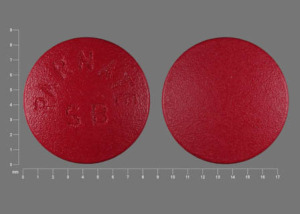Parnate and Alcohol/Food Interactions
There is 1 alcohol/food/lifestyle interaction with Parnate (tranylcypromine).
Tranylcypromine Food/Lifestyle
Major Food Interaction
CONTRAINDICATED: Foods that contain large amounts of tyramine may precipitate a hypertensive crisis in patients treated with monoamine oxidase inhibitors (MAOIs). The mechanism is inhibition of MAO-A, the enzyme responsible for metabolizing exogenous amines such as tyramine in the gut and preventing them from being absorbed intact. Once absorbed, tyramine is metabolized to octopamine, a substance that is believed to displace norepinephrine from storage granules.
GENERALLY AVOID: Alcohol may potentiate some of the pharmacologic effects of MAOIs. Use in combination may result in additive central nervous system depression and/or impairment of judgment, thinking, and psychomotor skills.
MANAGEMENT: In general, patients treated with MAOIs or other agents that possess MAOI activity (e.g., furazolidone, linezolid, procarbazine) should avoid consumption of products that contain large amounts of amines and protein foods in which aging or breakdown of protein is used to increase flavor. These foods include cheese (particularly strong, aged or processed cheeses), sour cream, wine (particularly red wine), champagne, beer, pickled herring, anchovies, caviar, shrimp paste, liver (particularly chicken liver), dry sausage, salamis, figs, raisins, bananas, avocados, chocolate, soy sauce, bean curd, sauerkraut, yogurt, papaya products, meat tenderizers, fava bean pods, protein extracts, yeast extracts, and dietary supplements. Caffeine may also precipitate hypertensive crisis so its intake should be minimized as well. At least 14 days should elapse following discontinuation of MAOI therapy before these foods may be consumed. Specially designed reference materials and dietary consultation are recommended so that an appropriate and safe diet can be planned. Patients should be advised to promptly seek medical attention if they experience potential signs and symptoms of a hypertensive crisis such as severe headache, visual disturbances, difficulty thinking, stupor or coma, seizures, chest pain, unexplained nausea or vomiting, and stroke-like symptoms. Patients should also be counseled not to use MAOIs with alcohol, and to avoid hazardous activities requiring complete mental alertness and motor coordination until they know how these agents affect them.
References (19)
- Pettinger WA, Soyangco FG, Oates JA (1968) "Inhibition of monoamine oxidase in man by furazolidone." Clin Pharmacol Ther, 9, p. 442-7
- Goldberg LI (1964) "Monoamine oxidase inhibitors: adverse reactions and possible mechanisms." JAMA, 190, p. 456-62
- Nuessle WF, Norman FC, Miller HE (1965) "Pickled herring and tranylcypromine reaction." JAMA, 192, p. 142-3
- Sweet RA, Liebowitz MR, Holt CS, Heimberg RG (1991) "Potential interactions between monoamine oxidase inhibitors and prescribed dietary supplements." J Clin Psychopharmacol, 11, p. 331-2
- Walker JI, Davidson J, Zung WWK (1984) "Patient compliance with MAO Inhibitor therapy." J Clin Psychiatry, 45, p. 78-80
- Ban TA (1975) "Drug interactions with psychoactive drugs." Dis Nerv Syst, 36, p. 164-6
- Darcy PF, Griffin JP (1995) "Interactions with drugs used in the treatment of depressive illness." Adverse Drug React Toxicol Rev, 14, p. 211-31
- Maxwell MB (1980) "Reexamining the dietary restrictions with procarbazine (an MAOI)." Cancer Nurs, 3, p. 451-7
- (2001) "Product Information. Matulane (procarbazine)." Roche Laboratories
- De Vita VT, Hahn MA, Oliverio VT (1965) "Monoamine oxidase inhibition by a new carcinostatic agent, n-isopropyl-a-(2-methylhydrazino)-p-toluamide (MIH). (30590)." Proc Soc Exp Biol Med, 120, p. 561-5
- Zetin M, Plon L, DeAntonio M (1987) "MAOI reaction with powdered protein dietary supplement." J Clin Psychiatry, 48, p. 499
- Domino EF, Selden EM (1984) "Red wine and reactions." J Clin Psychopharmacol, 4, p. 173-4
- Tailor SA, Shulman KI, Walker SE, Moss J, Gardner D (1994) "Hypertensive episode associated with phenelzine and tap beer--a reanalysis of the role of pressor amines in beer." J Clin Psychopharmacol, 14, p. 5-14
- Pohl R, Balon R, Berchou R (1988) "Reaction to chicken nuggets in a patient taking an MAOI." Am J Psychiatry, 145, p. 651
- (2001) "Product Information. Furoxone (furazolidone)." Roberts Pharmaceutical Corporation
- (2001) "Product Information. Nardil (phenelzine)." Parke-Davis
- (2001) "Product Information. Marplan (isocarboxazid)." Roche Laboratories
- (2001) "Product Information. Zyvox (linezolid)." Pharmacia and Upjohn
- Martin TG (1996) "Serotonin syndrome." Ann Emerg Med, 28, p. 520-6
Switch to consumer interaction data
Parnate drug interactions
There are 543 drug interactions with Parnate (tranylcypromine).
Parnate disease interactions
There are 21 disease interactions with Parnate (tranylcypromine) which include:
- blood pressure
- carcinoid syndrome
- headaches
- hyperthyroidism
- liver disease
- pheochromocytoma
- renal dysfunction
- alcohol
- hypertension/CVD
- liver disease
- pheochromocytoma
- hypoglycemia
- parkinsonism
- schizophrenia/bipolar
- seizures
- angina
- bipolar disorder screening
- diabetes
- hypotension
- renal disease
- seizures
More about Parnate (tranylcypromine)
- Parnate consumer information
- Check interactions
- Compare alternatives
- Pricing & coupons
- Reviews (107)
- Drug images
- Side effects
- Dosage information
- During pregnancy
- Generic availability
- Drug class: monoamine oxidase inhibitors
- Breastfeeding
- En español
Related treatment guides
Drug Interaction Classification
| Highly clinically significant. Avoid combinations; the risk of the interaction outweighs the benefit. | |
| Moderately clinically significant. Usually avoid combinations; use it only under special circumstances. | |
| Minimally clinically significant. Minimize risk; assess risk and consider an alternative drug, take steps to circumvent the interaction risk and/or institute a monitoring plan. | |
| No interaction information available. |
See also:
Further information
Always consult your healthcare provider to ensure the information displayed on this page applies to your personal circumstances.


